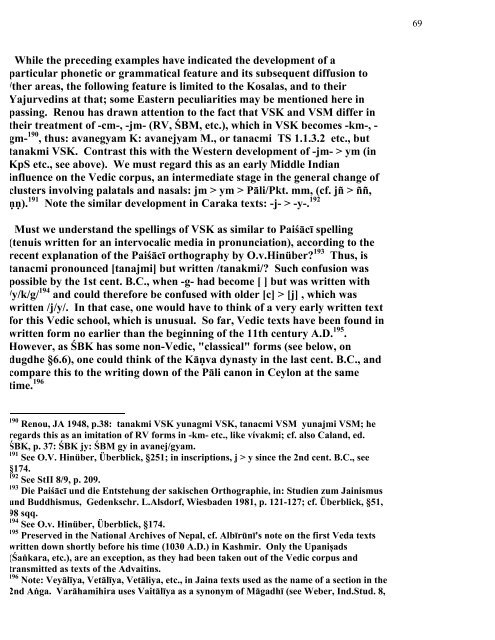TRACING VEDIC DIALECTS - People.fas.harvard.edu
TRACING VEDIC DIALECTS - People.fas.harvard.edu
TRACING VEDIC DIALECTS - People.fas.harvard.edu
You also want an ePaper? Increase the reach of your titles
YUMPU automatically turns print PDFs into web optimized ePapers that Google loves.
While the preceding examples have indicated the development of a<br />
particular phonetic or grammatical feature and its subsequent diffusion to<br />
/ther areas, the following feature is limited to the Kosalas, and to their<br />
Yajurvedins at that; some Eastern peculiarities may be mentioned here in<br />
passing. Renou has drawn attention to the fact that VSK and VSM differ in<br />
their treatment of -cm-, -jm- (RV, ŚBM, etc.), which in VSK becomes -km-, -<br />
gm- 190 , thus: avanegyam K: avanejyam M., or tanacmi TS 1.1.3.2 etc., but<br />
tanakmi VSK. Contrast this with the Western development of -jm- > ym (in<br />
KpS etc., see above). We must regard this as an early Middle Indian<br />
influence on the Vedic corpus, an intermediate stage in the general change of<br />
clusters involving palatals and nasals: jm > ym > Pāli/Pkt. mm, (cf. jñ > ññ,<br />
ṇṇ). 191 Note the similar development in Caraka texts: -j- > -y-. 192<br />
Must we understand the spellings of VSK as similar to Paiśācī spelling<br />
(tenuis written for an intervocalic media in pronunciation), according to the<br />
recent explanation of the Paiśācī orthography by O.v.Hinüber? 193 Thus, is<br />
tanacmi pronounced [tanajmi] but written /tanakmi/? Such confusion was<br />
possible by the 1st cent. B.C., when -g- had become [ ] but was written with<br />
/y/k/g/ 194 and could therefore be confused with older [c] > [j] , which was<br />
written /j/y/. In that case, one would have to think of a very early written text<br />
for this Vedic school, which is unusual. So far, Vedic texts have been found in<br />
written form no earlier than the beginning of the 11th century A.D. 195 .<br />
However, as ŚBK has some non-Vedic, "classical" forms (see below, on<br />
dugdhe §6.6), one could think of the Kāṇva dynasty in the last cent. B.C., and<br />
compare this to the writing down of the Pāli canon in Ceylon at the same<br />
time. 196<br />
190<br />
Renou, JA 1948, p.38: tanakmi VSK yunagmi VSK, tanacmi VSM yunajmi VSM; he<br />
regards this as an imitation of RV forms in -km- etc., like vívakmi; cf. also Caland, ed.<br />
ŚBK, p. 37: ŚBK jy: ŚBM gy in avanej/gyam.<br />
191<br />
See O.V. Hinüber, Überblick, §251; in inscriptions, j > y since the 2nd cent. B.C., see<br />
§174.<br />
192<br />
See StII 8/9, p. 209.<br />
193<br />
Die Paiśācī und die Entstehung der sakischen Orthographie, in: Studien zum Jainismus<br />
und Buddhismus, Gedenkschr. L.Alsdorf, Wiesbaden 1981, p. 121-127; cf. Überblick, §51,<br />
98 sqq.<br />
194<br />
See O.v. Hinüber, Überblick, §174.<br />
195<br />
Preserved in the National Archives of Nepal, cf. Albīrūnī's note on the first Veda texts<br />
written down shortly before his time (1030 A.D.) in Kashmir. Only the Upaniṣads<br />
(Śaṅkara, etc.), are an exception, as they had been taken out of the Vedic corpus and<br />
transmitted as texts of the Advaitins.<br />
196<br />
Note: Veyālīya, Vetālīya, Vetāliya, etc., in Jaina texts used as the name of a section in the<br />
2nd Aṅga. Varāhamihira uses Vaitālīya as a synonym of Māgadhī (see Weber, Ind.Stud. 8,<br />
69
















